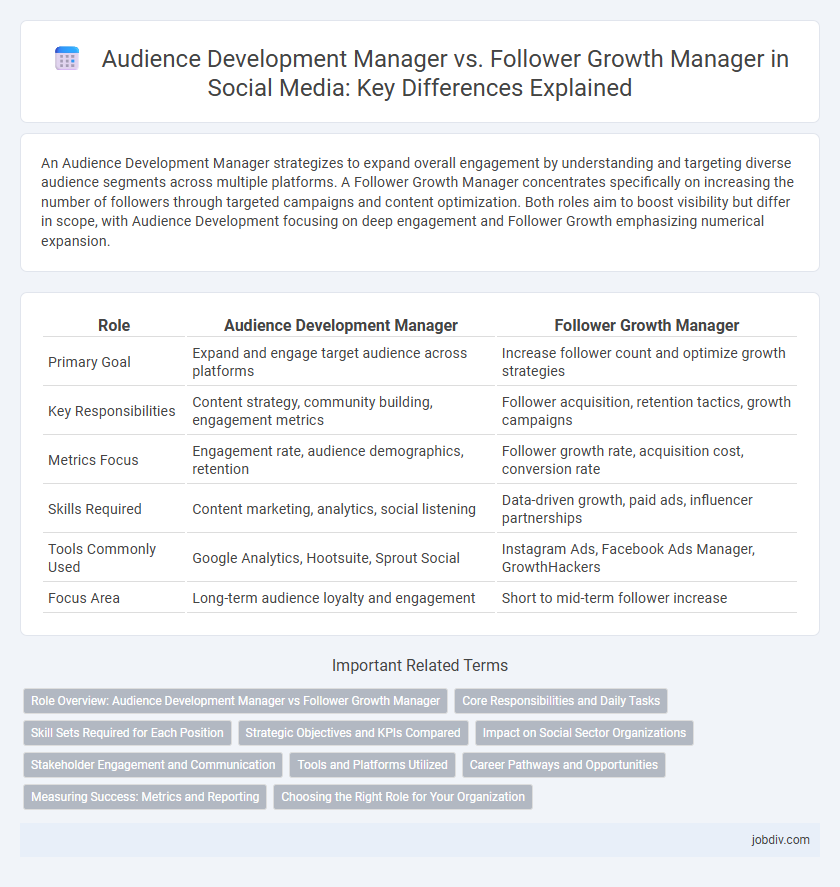An Audience Development Manager strategizes to expand overall engagement by understanding and targeting diverse audience segments across multiple platforms. A Follower Growth Manager concentrates specifically on increasing the number of followers through targeted campaigns and content optimization. Both roles aim to boost visibility but differ in scope, with Audience Development focusing on deep engagement and Follower Growth emphasizing numerical expansion.
Table of Comparison
| Role | Audience Development Manager | Follower Growth Manager |
|---|---|---|
| Primary Goal | Expand and engage target audience across platforms | Increase follower count and optimize growth strategies |
| Key Responsibilities | Content strategy, community building, engagement metrics | Follower acquisition, retention tactics, growth campaigns |
| Metrics Focus | Engagement rate, audience demographics, retention | Follower growth rate, acquisition cost, conversion rate |
| Skills Required | Content marketing, analytics, social listening | Data-driven growth, paid ads, influencer partnerships |
| Tools Commonly Used | Google Analytics, Hootsuite, Sprout Social | Instagram Ads, Facebook Ads Manager, GrowthHackers |
| Focus Area | Long-term audience loyalty and engagement | Short to mid-term follower increase |
Role Overview: Audience Development Manager vs Follower Growth Manager
An Audience Development Manager strategically analyzes data and audience behavior to create tailored content campaigns that enhance brand engagement and retention. A Follower Growth Manager primarily focuses on increasing social media followers through targeted growth strategies, influencer collaborations, and platform-specific tactics. Both roles aim to expand the brand's digital presence, yet the Audience Development Manager emphasizes sustained engagement while the Follower Growth Manager targets rapid audience expansion.
Core Responsibilities and Daily Tasks
An Audience Development Manager focuses on expanding and engaging a brand's overall audience through strategic content planning, analytics-driven insights, and cross-platform marketing campaigns. Their daily tasks include analyzing user behavior data, optimizing content distribution, and coordinating multi-channel promotions to enhance reach and engagement. In contrast, a Follower Growth Manager zeroes in on increasing social media followers by implementing targeted growth tactics, managing influencer partnerships, and tracking follower acquisition metrics to boost community size and brand visibility.
Skill Sets Required for Each Position
An Audience Development Manager requires strong data analysis skills, content strategy expertise, and proficiency in audience segmentation tools to drive targeted engagement. A Follower Growth Manager must excel in social media platform algorithms, trend identification, and influencer collaboration to increase follower count effectively. Both roles demand communication skills and adaptability but differ primarily in their focus on strategic audience insights versus rapid follower expansion tactics.
Strategic Objectives and KPIs Compared
An Audience Development Manager focuses on expanding brand presence through targeted content strategies, prioritizing KPIs such as engagement rates, audience retention, and conversion metrics. In contrast, a Follower Growth Manager emphasizes increasing follower count and network reach, with KPIs centered on follower growth rate, acquisition cost per follower, and platform-specific growth benchmarks. Both roles align strategically to enhance digital footprint but differ in optimizing either qualitative engagement or quantitative audience size.
Impact on Social Sector Organizations
Audience Development Managers strategically analyze engagement metrics and community demographics to tailor content that enhances meaningful interactions, significantly boosting social sector organizations' visibility and advocacy efforts. Follower Growth Managers concentrate on increasing follower counts through targeted campaigns and platform-specific strategies, which may drive rapid numerical growth but risk superficial engagement. Prioritizing audience development fosters deeper connections and sustained support essential for the long-term impact and mission success of social sector organizations.
Stakeholder Engagement and Communication
Audience Development Managers excel in stakeholder engagement by analyzing demographic data and user behavior to tailor communication strategies that foster long-term community loyalty. Follower Growth Managers prioritize rapid expansion metrics, utilizing targeted campaigns and influencer partnerships to boost follower counts and visibility. Effective communication in Audience Development centers on sustaining meaningful interactions, whereas Follower Growth emphasizes persuasive messaging to attract and convert new audiences.
Tools and Platforms Utilized
Audience Development Managers primarily utilize data analytics platforms like Google Analytics, HubSpot, and Adobe Audience Manager to identify, segment, and engage target demographics for tailored content strategies. Follower Growth Managers focus on social media management tools such as Hootsuite, Sprout Social, and native platform insights on Instagram, TikTok, and Twitter to increase follower counts and enhance community engagement. Both roles leverage A/B testing software and CRM systems like Salesforce to optimize audience interactions and growth metrics effectively.
Career Pathways and Opportunities
Audience Development Manager roles focus on strategic content optimization and analyzing user engagement metrics to expand diverse audience segments across digital platforms. Follower Growth Managers prioritize tactical social media campaigns and influencer collaborations to rapidly increase follower counts and drive brand visibility. Career pathways for Audience Development Managers often lead to digital marketing director positions, while Follower Growth Managers may advance into social media strategy or brand partnership leadership roles.
Measuring Success: Metrics and Reporting
Audience Development Managers track key performance indicators such as engagement rates, reach, and content interaction to measure success, using analytics tools to optimize strategies. Follower Growth Managers primarily focus on metrics like follower count increase, follower retention rates, and growth velocity, analyzing demographics and platform-specific data. Both roles utilize regular reporting dashboards and conversion tracking to assess campaign effectiveness and adjust tactics for sustained audience expansion.
Choosing the Right Role for Your Organization
Audience Development Managers focus on building long-term engagement by understanding audience behavior, crafting targeted content strategies, and optimizing user experience across multiple channels. Follower Growth Managers prioritize rapid increase in social media followers through tactics like influencer partnerships, viral campaigns, and platform-specific growth hacks. Selecting the right role depends on whether your organization values sustainable community growth and retention or fast-tracked social media expansion to boost brand visibility.
Audience Development Manager vs Follower Growth Manager Infographic

 jobdiv.com
jobdiv.com